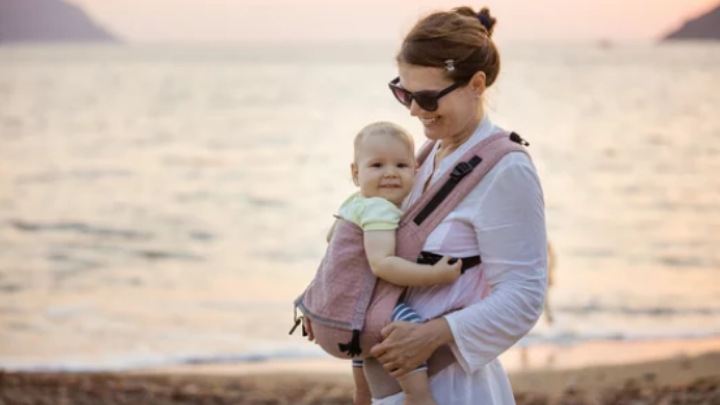Introduction
Summer days are known for their bright, sunny skies—which make for perfect moments to spend outdoors with your infant. But before you head outside, you'll want to be sure you have the right accessories for baby: one of the key items being a parasol or sunshade.
The sun can be harsh during those hot summer months, and it's important to take precautions to protect your infant. Parasols can be an effective way to do just that, as they provide a layer of shade over your little one and help keep them cool and comfortable.
But where do you start? We'll walk you through everything you need to know about parasols so you can make the best choice for your baby this summer. You'll learn about the different types available, how to choose the right size for your stroller or carrier, and more. Let's get started!
The Dangers of UV Radiation for Infants
As the summer sun beats down, it's natural to want to take advantage of the warm weather and spend some time outdoors with your infant. However, while a gentle stroll under the sun may seem harmless, you should be mindful of protecting your little one from the dangers of UV radiation. This is especially true for infants because their skin is more delicate than an adult's.
We already know that UV radiation can cause skin problems such as sunburns, but in infants these burns can be especially dangerous as they can lead to health complications like fever, dehydration, vomiting and diarrhea. Furthermore, your infant's eyes are also much more vulnerable to the sun's rays and require special protection from parasols or other forms of protection.
To protect your infant from these damaging effects of the summer heat and sun exposure, it is essential that you always carry a parasol with you when out for a walk in direct sunlight. Not only does this provide physical protection from the sun’s ultraviolet rays but also gives your baby a bit of relief from the heat.
How Parasols Protect Against UV Rays
No matter the season, it’s important to protect your infant from harmful UV rays. And an easy and affordable way to do this is by using a parasol. But how exactly do parasols safeguard your little one?
A parasol is designed to protect against UVA and UVB rays. While UVA rays can reach the skin directly, avoiding UVB rays is more difficult. Just as you can tell when you’ve been out in the sun too long because of a burning sensation, so too do UVB rays cause sunburns if your baby’s skin is exposed too long. A parasol can help absorb heat and block out those strong rays so that they don’t damage your little one’s delicate skin.
What’s more, many parasols are made with SPF fabric so that they offer even more protection against powerful UV radiation. It’s like a fine mesh that doesn’t impede airflow but instead cuts out the direct sunlight for additional coverage and safety for your infant. Therefore, you can rest assured that a good quality parasol will shield your child from the sun throughout the summer months.
Different Types of Parasols for Babies
Parasols come in various sizes and styles, designed to fit your baby's stroller, car seat, or pram. Some come with a variety of features or an adjustable angle for better sun protection. Here are a few types of parasols you may want to consider:
### Standard Parasols
These standard parasols fit most brands of strollers and car seats. They provide adequate coverage from the sun and shade your infant from the heat, but they don't offer adjustable angles or any other fancy features.
These are similar to standard parasols in that they fit most brands of strollers and car seats, but they offer more sun coverage due to their larger size. Additionally, they often have adjustable angles so you can get the perfect amount of shade for your child.
### Adjustable Parasols
These parasols are designed to be easily adjusted to different angles, so you can provide your infant with the perfect amount of protection from the sun no matter their activity. Not only that, but some also feature ventilation panels that keep your infant cool during hot days.
What to Consider When Choosing a Parasol
When choosing a parasol, there are several factors to consider. As a parent, the last thing you want is to skimp on quality and end up with a product that won't protect your little one from the sun's harsh rays.
Here is what you should take into account:
### Design
Opt for a design that offers adequate coverage for your stroller. Make sure the height is adjustable, so you can adjust the level of shade depending on the time of day. Look for models with UPF50+ fabric and an adjustable neckpiece, as this will ensure your infant gets maximum protection from the sun.
### Material
The material used in the parasol should be breathable and easy to clean – cotton and polyester are great choices. The fabric should also be durable enough to withstand any sudden changes in weather. Additionally, check that all stitching seams are secure and tight – no fraying edges!
### Mounting
It's important to find out how easy it is to mount your chosen parasol onto your stroller. Most good quality parasols come with clips or straps that make attaching them straightforward - many do not even require tools. For utmost convenience, look for models that fit most standard strollers without an adapter – this will save you from having to buy extra hardware components.
Proper Use of Parasols for Maximum Protection
Parasols are an essential accessory when caring for an infant in the summer sun. But it's important to know how to use the parasol correctly so that your baby is properly shielded from UV rays.
### Size Matters
When selecting a parasol, make sure you purchase one that's large enough to extend over your baby's stroller or car seat. The bigger the better, as you want to ensure as much coverage as possible.
### Attachment Point
You'll also need to consider where you attach the parasol – it should be securely affixed to stroller or car seat so that it won't be easily dislodged during use and will remain stable in windy conditions. Check out different parasols and accessories that are specially designed for this purpose.
### Precautions
Be aware of any situations where the parasol may be blocked by objects such as trees or buildings, as this can limit its effectiveness. Make sure you adjust the position of your baby and the parasol accordingly, so there is no risk of overexposure to direct sunlight. Lastly, ensure you regularly inspect your parasol for any tears or holes, which could allow UV rays through and compromise its protective capabilities.
Additional Sun Safety Tips for Infants
While a parasol is great for protecting your infant from the sun's damaging rays, there are a few additional tips that you should follow:
- Use Cooling Sprays and Sunscreens - A cooling spray can provide a barrier of protection to slow down the effects of too much sun exposure. Additionally, using an SPF 30+ sunscreen on your baby's skin can help to reduce their risk of getting burned by the sun.
- Create Shade Wherever Possible - Move your infant's stroller around to find shadier areas during outings and make sure they're wearing a hat with a wide brim. If you're at the beach or park and need some extra coverage, you can always use a portable beach tent or other large umbrella.
- Limit Exposure - When possible, try not to take your infant out in direct sunlight for too long. Stick to morning and evening walks or opt for shady spots indoors instead of spending hours outdoors in the midday sun when harmful UV rays are strongest.
By following these simple steps and using a parasol for extra protection, you'll have peace of mind knowing that your infant is staying safe in the summer sun!
Conclusion
It’s important to remember the importance of using a parasol when out and about on hot days with your infant. Parasols can provide protection from not just the sun’s rays, but also wind, rain, and bugs. In addition, they’re versatile and easy to use, and can be attached to any stroller for hassle-free care.
When choosing a parasol for your infant, look for one with a UPF of 50 or higher that gives you the most protection from the sun’s harmful rays. You should also avoid any dyes or chemicals, as these can irritate your infant's delicate skin.
When used correctly, the parasol can be an essential part of your summertime baby care routine, allowing you and your infant to enjoy the outdoors together under the shade of a parasol. Check our shop to see our Summer Essentials collection!



